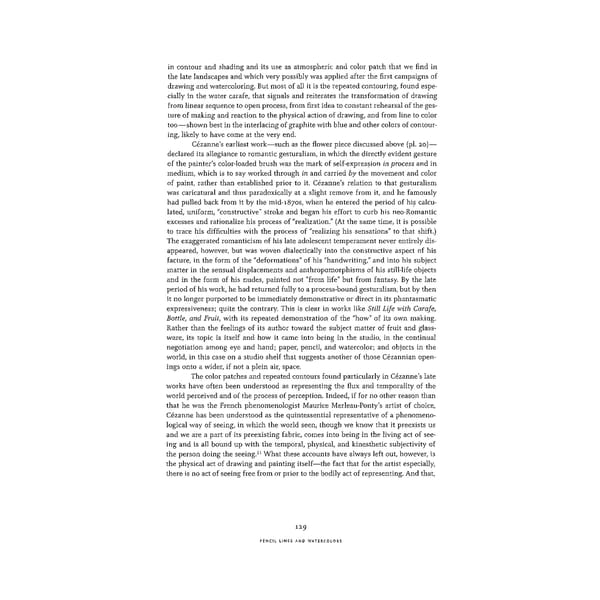in contour and shading and its use as atmospheric and color patch that we find in the late landscapes and which very possibly was applied after the first campaigns of drawing and watercoloring. But most of all it is the repeated contouring, found espe- cially in the water carafe, that signals and reiterates the transformation of drawing from linear sequence to open process, from first idea to constant rehearsal of the ges- ture of making and reaction to the physical action of drawing, and from line to color too—shown best in the interlacing of graphite with blue and other colors of contour- ing, likely to have come at the very end. Cezanne's earliest work—such as the flower piece discussed above (pi. 20)— declared its allegiance to romantic gesturalism, in which the directly evident gesture of the painter's color-loaded brush was the mark of self-expression in process and in medium, which is to say worked through in and carried by the movement and color of paint, rather than established prior to it. Cezanne's relation to that gesturalism was caricatural and thus paradoxically at a slight remove from it, and he famously had pulled back from it by the mid-18705, when he entered the period of his calcu- lated, uniform, "constructive" stroke and began his effort to curb his neo-Romantic excesses and rationalize his process of "realization." (At the same time, it is possible to trace his difficulties with the process of "realizing his sensations" to that shift.) The exaggerated romanticism of his late adolescent temperament never entirely dis- appeared, however, but was woven dialectically into the constructive aspect of his facture, in the form of the "deformations" of his "handwriting," and into his subject matter in the sensual displacements and anthropomorphisms of his still-life objects and in the form of his nudes, painted not "from life" but from fantasy. By the late period of his work, he had returned fully to a process-bound gesturalism, but by then it no longer purported to be immediately demonstrative or direct in its phantasmatic expressiveness; quite the contrary. This is clear in works like Still Life with Carafe, Bottle, and Fruit, with its repeated demonstration of the "how" of its own making. Rather than the feelings of its author toward the subject matter of fruit and glass- ware, its topic is itself and how it came into being in the studio, in the continual negotiation among eye and hand; paper, pencil, and watercolor; and objects in the world, in this case on a studio shelf that suggests another of those Cezannian open- ings onto a wider, if not a plein air, space. The color patches and repeated contours found particularly in Cezanne's late works have often been understood as representing the flux and temporality of the world perceived and of the process of perception. Indeed, if for no other reason than that he was the French phenomenologist Maurice Merleau-Ponty's artist of choice, Cezanne has been understood as the quintessential representative of a phenomeno- logical way of seeing, in which the world seen, though we know that it preexists us and we are a part of its preexisting fabric, comes into being in the living act of see- ing and is all bound up with the temporal, physical, and kinesthetic subjectivity of 11 the person doing the seeing. What these accounts have always left out, however, is the physical act of drawing and painting itself—the fact that for the artist especially, there is no act of seeing free from or prior to the bodily act of representing. And that, 129 PENCIL LINES AND WATERCOLORS
 Cézanne in the Studio: Still Life in Watercolors Page 143 Page 145
Cézanne in the Studio: Still Life in Watercolors Page 143 Page 145